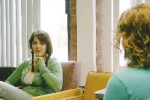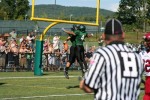Turf may change the games
Mounds of dirt and an 8-foot-tall fence still surround it. The sun beams down off its metal bleachers and blinds any passerby in the area. It may not look like much now, but in the fall, Castleton’s Spartan Stadium will be ready to turn heads.Aside from the permanent seating, press booth, restrooms and concession stand the stadium has to offer faithful fans, the state-of-the-art artificial turf will bring about some changes for CSC’s fall athletes.
Whether it is women’s soccer, men’s soccer or field hockey, all players on all rosters will have to make some adjustments.
“I’m excited to play on the turf, but I’ll also be missing the grass fields because it’s what I learned to play on,” said freshman field hockey player Amanda Kuchinski. “It’s what I grew up on.”
Both freshman field hockey player Angelica Mazzola and sophomore men’s soccer player Christopher Mulholland say they expect that the turf will make their style of play go quicker.
“When we play on turf it is a different game than grass,” said Mulholland. “We are much faster.”
Mazzola echoed Mulholland’s thoughts.
“I definitely think that the turf will have an impact on field hockey, it will make passing and the all around movement of the ball faster,” Mazzola said.
But is faster always better?
Junior women’s soccer player Ashley Hertford is torn on whether or not the switch to turf is a good idea.
“The soccer ball moves a lot quicker on turf and we are not used to that,” Hertford said.
She also points out that on grass, players of both sports have more control over the ball and things can get a little shaky when the game switches over to a flat, fast surface.
“It’s hard to be as fast as the ball,” said Hertford. “I prefer grass.”
But head field hockey and women’s lacrosse coach Tammy Landon is enthusiastic about the new turf.
“Often our grass fields are not able to be used because of standing water, snow or mud,” said Landon. “With the new turf we will be able to practice and have games because the turf conditions will always be consistent.”
Of course the question that still remains is whether or not the teams’ records will differ from last year’s and whether or not this turf will have anything to do with it.
“We’re no strangers to turf fields,” Mulholland said, eschewing any correlation between future records and the new surface.
Freshman Jacob Ferry shares Mulholland’s confidence.
“The transition should not be hard because we play quite a few away games on turf already and not all the games are going to be on turf,” said Ferry. “So some games and practices will still be on grass.”
All teams view the new stadium as a positive rather than a negative.
“The turf will also allow us to potentially host high school championships,” said Landon. “It will help us recruit quality student athletes in that respect.”
Both Landon and head men’s soccer coach John Werner are looking to strengthen their programs in hopes of bringing home more NAC championship titles in the future.
“Because we have tended to be a smaller, quick and skillful team, I think our players will adapt very quickly,” said Werner, whose players have already started thinking about the impact the turf will have on them.
“The turf will help our program because it allows for our individual skills along with team skills to develop,” sophomore men’s soccer player Colin Alfred said.
There is however, more than one catch.
“Four fall varsity teams using it as our home site will be a bit tricky to schedule,” Landon said.
But according to CSC’s Athletic Director Deanna Tyson in past press releases, all four teams, including the brand new football program, should be able to make it work smoothly.
Another area of concern is artificial turf related injuries that CSC’s athletes might face once they step on the field.
Mazzola claims that the turf gets hotter than grass, especially in direct sunlight. And she and Hertford agree that falling on the turf results in more severe injuries than if one had fallen on natural grass.
According to an article on the suite101.com Web site, athletes who play on a turf surface are more prone to suffer from the following injuries; turf toe, muscle trauma and turf burn. The article goes on to state that both turf toe and muscle trauma are connected to the surface resistance of the turf, and that wearing proper footwear can lower the individual’s risks.
Despite the scheduling conflicts that might arise and risks of new types of injuries, the overall consensus is that student athletes are looking forward for the chance to play on the turf and improve their games.
“I’m excited,” said Mazzola, “I see (turf) being an important aspect in raising the level of sports here at Castleton.






